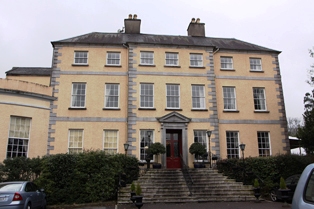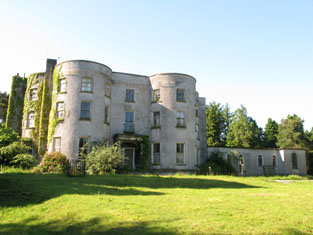Willsfort
Houses within 5km of this house
Displaying 32 houses.
Houses within 5km of Willsfort
Displaying 32 houses.
| House name | Description | |
|---|---|---|
| Vernon Mount | Built by Atwell Hayes in the 1780s, Vernon Mount was the residence of John Leslie in 1814 and of O. Hayes in 1837. Soon afterwards it was leased to William Lane and he was the occupier at the time of Griffith's Valuation, holding the house valued at £55 from Attiwell Hayes. The Hayes sale rental of 1851 describes this house as "a large handsome building erected by the present owner's father at a cost of £5000". It was leased by the Hayes family to William Lane in 1839. A building still exists at this site. | |
| Myrtle Hill | Richard Barter was leasing this house to Denis Ahern at the time of Griffith's Valuation, when it was valued at £12. Myrtlehill Farm is still extant at the site. | |
| Ballygarvan House | Joseph B. Coghlan held this property in fee at the time of Griffith's Valuation, when it was valued at £30. It is still extant. | |
| Ballynametagh | At the time of Griffith's Valuation, John Kingston was leasing this house to Daniel Coates, when it was valued at £9. A modern house and farm occupy this site now. | |
| Ravenswood or Monroe House | Michael Roberts was leasing this property to Ralph Westropp at the time of Griffith's Valuation, when it was valued at £38. On the 1st edition Ordnance Survey map it is labelled Monroe House but later came to be known as Ravenswood House. Monroe House appears at a different location (W715627) on the 25-inch Ordnance Survey Map of the 1890s. Ravenswood was occupied by the Westropp family until the twentieth century. |

|
| Killanully | Rev. Edward Newenham was leasing this property to Michael Donegan at the time of Griffith's Valuation, when it was valued at £9. | |
| Ballea Castle | Francis Hodder held this property in fee at the time of Griffith's Valuation, when it was valued at £24 10s. Lewis also refers to it as his seat in 1837. Local sources suggest that It was originally built by the McCarthy family and later acquired by the Hodders. In the 1940s the Irish Tourist Association survey refers to it as being occupied by F. Dorman, retired engineer, and that it was the oldest occupied castle in Éire. Though much altered over the years, it is still extant and occupied. |

|
| Ballea Mill | Thomas Hewitt was leasing this property to Thomas Sullivan at the time of Griffith's Valuation, when it was valued at £20, including the adjacent mill. The latter property is labelled "in ruins" on the 25-inch Ordnance Survey map of the 1890s. | |
| Ballea A | At the time of Griffith's Valuation, Thomas Hewitt was leasing this property to Shaw Busteed, when it was valued at almost £10. Buildings are still extant at the site. | |
| Hilltown House (Carrigaline) | Hilltown House was leased by Thomas Busteed from Anne Cook at the time of Griffith's Valuation, when it was valued at £8. It is labelled as Hilltown House on both the 6-inch and 25-inch Ordnance Survey maps. | |
| Maryborough | In 1786 Wilson refers to Maryborough as the seat of Mr Newnhan and it was also a Newenham home in the 19th century, occupied by R. Newingham in 1814, by Edward Eyre Newenham in 1837 and at the time of Griffith's Valuation. He held the property in fee and the buildings were valued at £80. Thomas Sherrard held a mansion house valued at £61 in this townland in 1906. It is now part of a large hotel complex. |

|
| Doughcloyne | Originally the home of the Ronayne family, it passed by marriage to the Sarsfields. Occupied by Dr Sarsfield in the 1770s and 1780s, by Mr Haynes in 1814, by D. Sarsfield in 1837 and by Thomas R. Sarsfield in the early 1850s, who held it in fee, value £43. In 1894 Slater notes it as the seat of Capt. T.R. Sarsfield. This house is no longer extant. | |
| Oldcourt | Oldcourt was the seat of the Goold family baronets until 1852 when it was bought by Alexander Glasgow. The sale rental of March 1852 includes a lithograph of Oldcourt. Griffith's Valuation records Glasgow holding the property in fee and the buildings were valued at £68. The Glasgows leased the house until it was bought in the early 20th century by Henry O'Shea although Alexander J. Glasgow is recorded as the occupier in 1906 when it was valued at £51. Henry O'Shea sold it to the Brothers of Charity in 1934 whose services used it as a Special Needs school. It is still extant. |

|
| Montpellier | A house occupied by the Reverend Morgan O'Donovan in 1837 and by Morgan O'Donovan in the early 1850s. The house was held in fee by the O'Donovans and was valued at £55. There is no trace of this house now as modern development has taken place in the area. | |
| Chetwynd | The Pigotts were established at Chetwynd in the early 18th century and Wilson refers to it as their seat in 1786. By the end of the century they were resident in county Laois. In 1837 J. Forrest was the proprietor of Chetwin and in the mid 19th century William Bateman occupied the house, valued at £25, which he held from John Dennis. Two houses are marked on the first Ordnance Survey map for Chetwynd. It is not clear which one was the Pigott house. | |
| Ballincurrig | W.C. Logan occupied Ballincurrig Cottage in 1837 and William Coppinger occupied a house at Ballincurrig valued at £33 and held by him in fee at the time of Griffith's Valuation. | |
| Cleve Hill | Samuel Perrott was residing at Cleve Hill in 1837 and in the early 1850s when the house was valued at £68 and held from Alexander McCarthy. Cleve Hill a modern family mansion on 13 acres was advertised for sale in October 1873, the estate of Joseph Gadsden Nash and Arthur Power Harty, bankrupts. | |
| Clifton | John Moore Travers inhabited this house in the first half of the 19th century. At the time of Griffith's Valuation Clifton was valued at £65 and held from the Earl of Bandon. John M. Travers only child Elizabeth married in 1827 Sir William Henry St Lawrence Clarke, Baronet. Later the home of Nicholas Murphy and in the 20th century in use as a convent. | |
| Besborough | In the 1770s the residence of Allen Esq. The seat of the Pike family for most of the 19th century. Occupied by J. Spence in 1814 and by Ebenezer Pike in 1837 and in the early 1850s. He held the property from the representatives of Bousfield and the house was valued at £78. This house was used as a convent in the 20th century. http://www.askaboutireland.ie/reading-room/history-heritage/big-houses-of-ireland/bessborough-house-and-est/index.xml | |
| Hampstead | The residence of G. Britton in 1814 and of Lieutenant Boyle Hill in 1837. Occupied by John H. Bainbridge at the time of Griffith's Valuation. He held the property in fee and the house was valued at £22. The house is not labelled on the 25-inch Ordnance Survey map of the 1890s and is no longer extant. | |
| Frankfield | Located on the side of what is now the Frankfield Golf Club, Frankfield House was occupied by S. Lane in 1837 and by the Very Reverend H. J. Newman in the mid 19th century. Reverend Newman held it from William Lane and the buildings were valued at £60. | |
| Lakeview | Occupied by Miss Allen in 1837 and by William Prittie Harris in the early 1850s when the house was valued at £28 and held from Sir William Chatterton. In the 1870s Richard Harris of Lakeview, Cork, owned 169 acres. This house no longer exists. | |
| Dundanion Castle | The residence of the architect Sir Thomas Deane in 1837, valued at £78 in the early 1850s and held from Richard Sampson. Sold by Sir Thomas to William Wise in 1860 and by Wise to William Thornton in 1868. A residence is still extant at this site. | |
| Garrane | In the early 1850s Francis Hennis occupied a house valued at £30 from William Howe Hennis. A building still exists at this site. | |
| Grange | H. Conron occupied Grange in 1837 and at the time of Griffith's Valuation when the buildings were valued at £40 and held from J.D.C. Beamish. Hatton Condon was still living at Grange in the 1870s. In 1894 Slater records Grange as the seat of E.R. Conron. This house no longer exists. | |
| Lehenaghbeg | A house valued at £14 in the mid 19th century and held by Edward Casey from James H. S. Barry. Edward Casey was the owner of 121 acres at Lehenaghbeg in the 1870s. | |
| Lehenagh | Occupied by T. Curtis in 1837. By the early 1850s Mary Curtis was resident holding the house valued at £28 from the Reverend Edward H. Newinham. | |
| Lehenagh House | A home of a member of the Newingham family in 1814 and of Charles Mathew in the mid 19th century.James Mathews of Lehenagh owned 107 acres in the 1870s. This house no longer exists. | |
| Ashton | A house occupied by John Cotter from at least 1814 until his death in 1864 and by Mrs Catherine Cotter until at least 1871. It is not clear if John Cotter was a member of the Cotter family, baronets. The house is now part of the Ashton School complex. | |
| Charlemont House | Charlemont House was leased by Charles Evanson from Nicholas G. Allen at the time of Griffith's Valuation, when it was valued at £20. It was included in the sale of Evanson property in the Landed Estates Court in November 1862. It is still extant. | |
| Wilton | In 1786 Wilson refers to "Willtown" as the seat of Mr. Izod. Charles H. Leslie occupied Wilton in 1814 and in 1837. By the mid 19th century Matthew Leslie was resident, holding the house valued at £55 from John Craig and H. Mitchell. A college is now located at this site. | |
| Mounthovel House | In 1786 Wilson refers to Mounthovel as the seat of Mr. Farmer. At the time of Griffith's Valuation, Mout Hovel House was occupied by Edward Newenham leasing from the Atkins estate and valued at £8. It is no longer extant and the area is now occupied by modern housing. |

